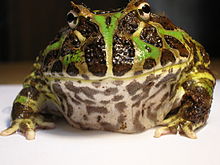- Argentine horned frog
-
Argentine horned frog 
Conservation status Scientific classification Kingdom: Animalia Phylum: Chordata Class: Amphibia Order: Anura Family: Leptodactylidae Genus: Ceratophrys Species: C. ornata Binomial name Ceratophrys ornata
Bell, 1843The Argentine Horned Frog (Ceratophrys ornata), also known as the Argentine wide-mouthed Frog or Pacman frog, is the most common species of Horned Frog, from the rain forests of Argentina, Uruguay and Brazil. A voracious eater, it will attempt to swallow anything that moves close to its wide mouth, such as insects, and rodents, lizards and other frogs, even if it would suffocate in the process.
Contents
Characteristics
The females can grow to be 16.5 centimeters (6.5 inches) snout to vent (SV) and the males 11.5 centimeters (4.5 in) SV. The average lifespan is 6 to 7 years, however they can live up to 10 years or more in captivity.[1][2] The Horned frogs' most prominent feature is its mouth, which accounts for roughly half of the animal's overall size. Coloration is typically bright green with red markings, though dark green, parti-color black and albino versions also exist. Sexing this species is very difficult before sexual maturity is reached. Dimorphism traits between the two sexes are size difference and males possessing dark pigmented throats and nuptial pads on the forelimbs.
Feeding
Horned frogs hunt by remaining motionless, and waiting for prey. They will try to eat anything that can fit in their mouths, and some things that can't. In the wild, their typical diet would include rodents such as mice, small reptiles, as well as large spiders and insects such as locusts.
Horned frogs are well known for their fearless reputation. They will attempt to consume animals, sometimes even the size of themselves. If threatened by a larger animal such as a human, these frogs can deliver a painful bite as they have several odontoid projections (not teeth per se) along their bottom and top jaws. Sometimes they will even jump towards their attacker, no matter their size and power. However, in captivity this frogs' natural diet is fairly easy to recreate. When kept as a pet, the Horned frog is usually fed mainly on large adult locusts, black and brown crickets and mice; they also enjoy – depending on size – live fish. However, studies have proven[citation needed] primarily feeding a Horned frog mice causes fat build-up, which often results in blindness and death.
Reproduction
Reproduction is sexual. The Argentine Horned frog's females deposit about 2000 eggs in water and within two weeks they become tadpoles.
Keeping as a pet
Known in the pet industry as Pacman frogs, the Argentine variety is usually the hardiest species and is easy to care for. The Argentine Horned frog has simple requirements as a pet. An aquarium of at least ten gallons will do. Because they are very poor swimmers and spend their time buried in soil and leaf litter in the wild, the only water in the tank should be a shallow bowl - with water shallow enough that they cannot possibly drown in it. The rest of the tank should be peat moss or coconut fiber or similar substrate, deep enough that they can bury themselves in it as they would in their natural habitat. Care must be taken to avoid substrate with rocks or gravel that could be eaten by accident while hunting, causing fatal impactions in the stomach.
It is recommended to keep horned frogs alone to avoid cannibalism. A preferred temperature for the cage is from 78 to 82 degrees Fahrenheit, and humidity between 60%-70%. A heating pad can be used to regulate temperature, however the pad should be placed on one side of the tank and not underneath in order to prevent burrowed frogs from over-heating. A thermometer and hygrometer are also needed to evaluate temperature/humidity. Daily misting with distilled water (eliminates hard water stains on tank glass) can help achieve optimal humidity levels. Do not directly spray your frog with distilled water or offer distilled water for soaking. Only de-chlorinated tap water, or preferably spring water should be used for soaking purposes.
Juveniles can be fed 3-4 appropriately sized vitamin/calcium dusted crickets every other day. Adults can be fed adult crickets, roaches, or earthworms three times a week. Also dust with supplements once a week for adults. Mice can be feed once or twice a month but should not be a diet staple. Frogs have difficulty digesting mammalian tissue and the high fat content of mice can lead to fatty liver disease.
Gallery
References
1. "Argentine horned frog." The World Book Encyclopedia. 2006 ed. Vol 1 pg. 275.Chicago.World Book,Inc. 2006.
2. De Vosjoli, Philippe. The General Care and Maintenance of Horned Frogs. California: Advanced Vivarioum Systems, 1989
3. Mattison, Chris. Frogs and Toads of the World. New York: Facts of Filem, 1986.
External links

This Leptodactylidae article is a stub. You can help Wikipedia by expanding it.






